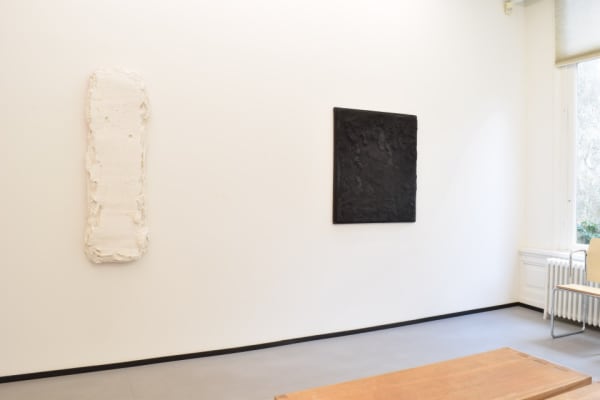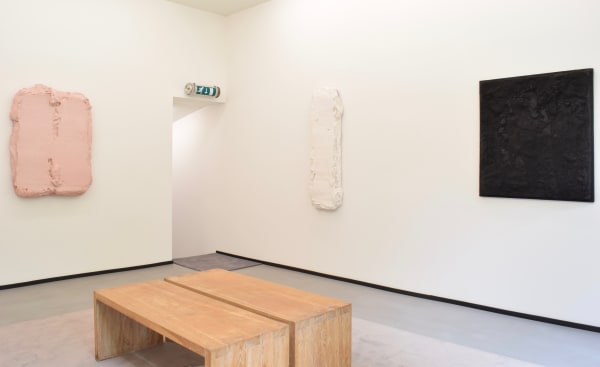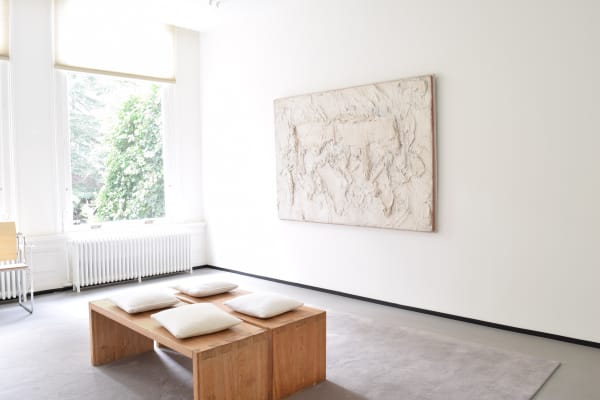Bram Bogart | The Monochromes
Bram Bogart, independent painter
Bram Bogart is a painter who hardly needs any introduction. Many know him as the painter of impasto paintings, lavish use of materials, multicoloured, vivid.
Work on his impressive oeuvre continued until six months before his death. His reputation was significant and substantial, especially in his adopted country of Belgium, from where he continued to build his international career.
He and his wife Leni always welcomed the countless collectors, museum directors and gallerists with open arms. Although he was still involved with the preparations for his major retrospective in the Cobra Museum in 2012, he did not live to see its opening in September of that year. He died in his chateau in Kortenbos on May 2nd 2012.
Bram Bogart never joined an artists' group, not in Delft, where he was born, nor in The Hague nearby. Nor in Paris where from 1951 he lived in a former tannery on the Rue Santeuil, where Cobra artists like Appel and Corneille also lived.
Bogart always remained the independent artist, it is true he had an open mind regarding the art world, but without conforming to any artists' associations, movements or group ideals. Nevertheless Bogart kept both feet on the ground in the art world, first in Delft and The Hague and after the war in Paris, Rome and Brussels.
Bram Bogart and Jan Schoonhoven
In post-war Paris Bogart found himself in the middle of a reburgeoning art scene. At that time artists from all over the world were coming to Paris. One of these was Bogart's friend from his hometown of Deft, Jan Schoonhoven.
In the Parisian studio Schoonhoven saw the textured impasto canvases that had been gaining wide international recognition for Bogart since the mid-nineteen-fifties. These were the works that were not always properly understood in the Netherlands. Bogart's material paintings such as 'Rhythme Blanc' (1954), an almost monochrome painting with clear Parisian influences of the art informel, were as far removed from geometric abstract tendencies as from Cobra. For artists who did not associate themselves with the colourful lyricism of Cobra, Amsterdam - i.e.: the Stedelijk Museum under Willem Sandberg - was an unassailable bastion during the early nineteen-fifties. For a long time after the sensational 1949 Cobra exhibition in Amsterdam's Stedelijk Museum colourful lyricism remained the first-choice and dominant in programming and purchasing policy. Bram Bogart and Kees van Bohemen kept in contact with friends in Delft and The Hague even after they moved to Paris. This contact meant a lot for those who remained at home. It offered a window onto a different cultural climate - and the confirmation that there was life after Cobra. Schoonhoven's first, hardly raising themselves from the surface, bas reliefs were created in 1956, immediately on his return from Paris. Bogart's material paintings were an undeniable influence. (from: Antoon Melissen, Jan Schoonhoven, Rotterdam 2015).
Bogart - travel and a meeting in Rome
In the nineteen-fifties Bogart travelled a great deal and took part in exhibitions in London, Paris, Amsterdam, Vienna, Rome, various cities in Germany and in Sweden. His first introduction to the new, American art came at exhibitions in Frankfurt and Paris. In 1959, during a two-year stay in Rome, Bogart also met up with his fellow-countryman Willem de Kooning. He was staying in Rome for four months in the winter of '59/60 and the artists met regularly in café Rosati. De Kooning was mainly working there on works on paper, collages also with powerful compositions in black enamel paint. Bogart exhibited there at his gallery L'Attico.
Bogart and the monochrome painting
The theme of this exhibition is the monochrome work of Bram Bogart. However much Bogart may be known by the public at large as the painter of the grand, compelling and often multicoloured painting, in my opinion his monochrome works are some of the best I have ever seen.
At that time, making a painting in one colour, whether white, black or brown gave me a form of restfulness in relation to the other paintings. (interview with W. van den Bussche in 'Bram Bogart Retrospectief', Oostende 1995).
Most of the paintings in this exhibition come from the artist's studio and collection and have been carefully selected together with Bogart's wife Leni and his son Bram. I am extremely grateful to both for their unfailing hospitality during my many visits to Kortenbos.
Paul van Rosmalen
September 2016
translation: FemmeVertaal
















